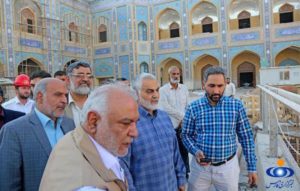Arbaeen pilgrimage and Iran’s Shia crescent
Oct 28th, 2018Hassan Dai, October 2018
The Iranian regime has been trying to gradually take the control of this event and utilize it for its domestic and regional goals specifically to expand its influence in Iraq, and strengthen the Shia crescent, a necessary step in its quest to dominate the Middle East.
——————————————
Introduction
On October 30 and 31, millions of Shiite Muslims will gather in Iraq’s holy city of Karbala to mark Arbaeen, a religious ritual that commemorates the end of the 40-day mourning period for the killing of Imam Hussein, the grandson of Prophet Muhammad and the third Imam of Shiites. Majority of the pilgrims have marched the 80 Km distance from the city of Najaf to Karbala. According to official sources, Arbaeen attracted nearly 17 million pilgrims last year, the majority of whom were Iraqis with more than one Million Iranians participating in the event.
The Arbaeen pilgrimage continues to grow and has become one of the most important religious ceremonies in the world and a show of force for the Shia community. The Iranian regime has been trying to gradually take the control of this event and utilize it for its domestic and regional goals specifically to expand its influence in Iraq, and strengthen the Shia crescent, a necessary step in its quest to dominate the Middle East.
In order to achieve this goal, the Iranian regime is using its financial, political and religious influence in Iraq and at the same time, dedicating enormous resources in Iran and mobilizing multiple government agencies to promote the pilgrimage in Iran and encourage Iranians to participate.
Export of revolution, Shia crescent and Importance of Iraq
In 1979, Ayatollah Khomeini, and a group of clergymen affiliated to him, seized control of power in Iran. From the onset, Khomeini’s regime utilized all means possible to establish its brand of fundamentalism in Iran and export it throughout the Islamic world. In order to consolidate their Shia base, the Iranian leaders view neighboring Iraq as their prime target due to its majority Shiite population and the fact that the shrines of six Shiite Imams are located in the country, including the most veneered amongst them all, the first Imam Ali and his son Hossein who are buried in the cities of Najaf and Karbala.
Following the US invasion of Iraq and the fall of Saddam Hussein, the Shia majority became the dominant political force in the country. This was a turning point for Iran who used its Iraqi proxies and allies to expand its influence in Iraq and dominate the country’s political and military apparatus.
Iran’s dominant position in Iraq and its expanding military involvement across the Middle East has revived the dream of an Iranian-led Shia crescent. During the commemoration ceremony of Islamic Revolution in February 2014 in the city of Kerman, Ghassem Soleimani, the commander of Quds Force declared: “What is the Shia’ Revival? Since Imam Ali was martyred 14 centuries ago, the reign of Umayyad and Abbasid caliphates and later, under the Ottomans, the Sunnis have been ruling the Islamic world and nowhere the Shiites had the opportunity to express freely their faith… The current Shia Revival, under the Iranian leadership makes Iran the center of gravity in the region and provides Iran with security and power. We should remember that the Shia’ crescent, is not only political, it is an economic power because most of the Middle East energy resources are located in Shia regions…, Iraq was liberated Iraq from the American dominance after the fall of Saddam thanks to the Iraqi Shiites who relied on Iranian leadership.”
While Iran enjoys enormous political and military influence in Iraq, it lacks adequate influence in Iraq’s religious establishments, especially in the seminary of Najaf, the most important center of religious authority for the Shiites and the home to Grand Aytollah Ali Sistani, the most influential Shia spiritual leader in the world. Sistani and the vast majority of clerics at the Najaf Seminary refuse to recognize the religious authority of Tehran’s rulers and oppose the Velayat al-Faqih, which is the Iranian regime’s model of theocracy based on a jurisprudential interpretation of Islam. The Iraqi government and the law give Sistani the authority over Iraq’s Shiite shrines and his appointed custodians control the pilgrimage observances in Iraq’s shrine cities.
Shia holy shrines and pilgrimage
In order to overcome these obstacles and expand its religious authority in Iraq, Iran has been pursuing a three-fold strategy. Firstly, by using financial and political leverages to ensure the primacy of clerics trained in the Iranian seminary of Qom and loyal to the Iranian ideology, over clerics trained in the relatively non-political tradition of the Najaf seminary. Secondly, by spending huge amounts of resources to reconstruct the Shiite shrines in Iraq and consequently, take control of their management in the long run. Thirdly, by taking control of the pilgrimage observances in Iraq’s shrine cities, notably the Arbaeen procession.
After the fall of Saddam, Iran created a new organization called “The Headquarters for the Restoration of Holy Shrines (HRHS)” to restore and develop Shiite shrines in Iraq and Syria and oversee Iranian pilgrimages to Iraq especially the Arbaeen procession. HRHS is under the Supreme Leader’s direct supervision and its current chief is Hassan Pollarak who according to the Iranian press is a former Quds force commander.
Ghassem Soleimani, commander of Quds Force visits the construction project of Shrines in Karbala, September 2018
HRHS has spent billions of dollars for its projects in Iraq and is gaining more control over the management of the shrines. It has also built several hospital and care centers for pilgrims and has acquired large number of hotels and other facilities around the shrines.
Arbaeen Pilgrimage
Each year, millions of pilgrims from around the world visit the Shia holy shrines in Iraq including several million Iranians. The most important pilgrimage is the Arbaeen that extends over a week. The Iranian regime aims to increase the number of Iranian pilgrims and use this participation and other tools at its disposal to control these important religious events.
To carry out this mission, several Iranian ministries and government organizations are mobilized, and their activities are under the direct supervision of Supreme Leader’s office. The Revolutionary Guards-controlled “The Headquarters for the Restoration of Holy Shrines (HRHS)” is one of the main organization involved in overseeing the activities in Iraq and coordination with Tehran proxies in the holy cities in Iraq. Since 2013, the Hajj and Pilgrimage Organization in Iran created a new entity called “the central headquarter for Arbaeen pilgrimage” to coordinate the administrative and operational duties related to the pilgrimage.
Throughout the year, the government, media and religious institutions are mobilized to encourage the Iranians participate in the pilgrimage. Thousands of religious centers and Mosques are involved in organizing pilgrimage tours to Iraq, monitor and facilitate the legal procedures and provide a wide range of financial and travel assistance to the pilgrims. The Iranian organizations work with their Iraqi counterparts to assist the pilgrims in Karbala and on the road between Najaf to Karbala. Hundreds of rest areas have been established to welcome the pilgrims and provide them with food and resting facilities.
Domestic goals
By promoting and sponsoring the pilgrimage, the Iranian regime aims to attain several domestic goals. In Iran, it increases the religious fervor among Iranians and presents the regime as the guardian of their faith, creating a connection between the regime and the population and boosts the regime’s legitimacy.
Moreover, by monitoring and coordinating the activities of religious centers involved in the Arbaeen pilgrimage, the regime tightens its control over the religious activities of Iranians across the country.
The pilgrimage is also a formidable recruiting tool for the Iranian regime and especially the Revolutionary Guards to find candidates that are ideologically loyal to the regime and ready to fill the ranks of security and military institutions.
Regional goals
Arbaeen also serves Iran’s regional policies. The Iranian leaders believe that their military and political influence in the region give them the stature to claim the leadership of the Shia world and consequently take credit for the Arbaeen show of force. This helps Iran in the current rivalry with Saudi Arabia in the region and it is also used as a propaganda tool to undermine the Haj pilgrimage that is managed by the Saudis. Accordingly, the Iranian regime utilizes this show of force, its role as the leader of Shia world and its regional influence as a leverage to project its power in Iran and solidify its domestic position. On October 21, a week before the pilgrimage, Ghassem Soleimani the commander of Quds force posted a tweet and emphasized the significance of the event in current rivalry between Iran and Saudi Arabia. He wrote: “The participation of 20 million Shiites in the Arbaeen March in Iraq, which borders Saudi Arabia is beyond description. This show of force is more powerful than a military parade.”
Iran’s increasing role in the Arbaeen pilgrimage and the management of shrines helps Iran enhance its religious authority within the Iraqi and other Shiite communities in the region. This religious authority is much needed to assist the Iranian political surrogates and proxy militias across the region.
In order to take control of the Arbaeen pilgrimage, Iran tries to turn it to a political event with anti-American and anti-Israeli connotation. During the pilgrimage and especially the march from Najaf to Karbal, the pilgrims from Iran or foreign Shiites loyal to the Iranian regime carry anti-American and anti-Israeli signs and promote the Iranian leadership as the guardian of Shia Islam. The Iranian clerics and preachers who accompany the pilgrims try to present the event as an illustration of the historic struggle to liberate the Islamic nation from the domination of Western crusaders.
The Arbaeen pilgrimage provides Iran and the Revolutionary Guards’ Quds Force with a unique opportunity to recruit foreign Shiites who adhere to the Iranian cause. For several month prior to Arbaeen, the Iranian regime uses its vast network of Islamic centers around the world to enroll pilgrims and organize tours to Iraq. Several centers in Europe are specifically involved in organizing the Arbaeen tours.
Al Mustafa University with its global network is one of Iran’s organizations abroad responsible for the organization of foreign pilgrims. For the past three years, Iran has been establishing enrollment centers in several European cities. According to Iranian press, nearly 3000 students from Al-Mustafa branches in Iran participate in the pilgrimage.
*Hassan Dai is an Iranian-American investigative journalist and political analyst specialized in the Iranian regime’s activities in the Middle East and pro-Iran activities in the West. He is the editor of Iranian American Forum.




Good post. I learn something new and challenging on websites I stumbleupon on a daily basis. Its always interesting to read articles from other writers and practice something from other sites.
An impressive share, I just given this onto a colleague who was doing a little analysis on this. And he in fact bought me breakfast because I found it for him.. smile. So let me reword that: Thnx for the treat! But yeah Thnkx for spending the time to discuss this, I feel strongly about it and love reading more on this topic. If possible, as you become expertise, would you mind updating your blog with more details? It is highly helpful for me. Big thumb up for this blog post!